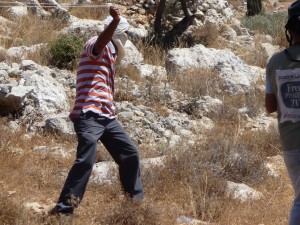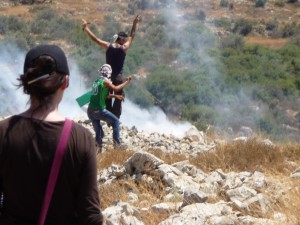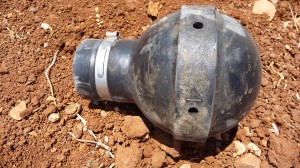Näppeligen ett neutralt sådant i vart fall.
Upplysandde läsning om hur väl den palestinska propagandan får genomslag i alla delar av samhället även bland vetenskapsmän. Naturligtvis har han några judiska vänner vars försök till att nyansera han avfärdar på ett rätt föraktfullt vis
Sidan verkar vara borttagen så jag citerar den i sin helhet från Reader.
The Theater of a Palestinian Apartheid Wall Demonstration
 Apparently, it’s a regular event for Israeli soldiers, Palestinian demonstrators, international activists, and foreign press alike. Every Friday at 12:00 noon 60-100 men and boys meet in the olive groves between their West Bank village of Ni’lin and the security fence—apartheid wall, West Bank barrier, whatever you want to call it—to protest the wall’s existence. A 700-kilometer long wall selectively incorporates and excludes populations and resources into and out of Israel. According to the Economist, completion of the barrier will remove 1/3 of Ni’lin land. I had arrived in Tel Aviv at 3AM to continue to make a film about divided cities and territories around the world. I had just been to Nicosia, Cyprus, a city divided by the UN because of a war between Greece and Turkey over 30 years ago. An activist in Cyprus there told me about this West Bank anti-wall protest.
Apparently, it’s a regular event for Israeli soldiers, Palestinian demonstrators, international activists, and foreign press alike. Every Friday at 12:00 noon 60-100 men and boys meet in the olive groves between their West Bank village of Ni’lin and the security fence—apartheid wall, West Bank barrier, whatever you want to call it—to protest the wall’s existence. A 700-kilometer long wall selectively incorporates and excludes populations and resources into and out of Israel. According to the Economist, completion of the barrier will remove 1/3 of Ni’lin land. I had arrived in Tel Aviv at 3AM to continue to make a film about divided cities and territories around the world. I had just been to Nicosia, Cyprus, a city divided by the UN because of a war between Greece and Turkey over 30 years ago. An activist in Cyprus there told me about this West Bank anti-wall protest.
The taxi driver at Ben Gurion Airport outside of Tel Aviv knew what I was going there to do, to video document the demonstration from the Palestinian side of the separation wall. He refused to take me saying, “it is not even in Israel.” An hour later he had not found a rider and I had not found a driver that knew where Ni’lin was so I re-asked the driver and for an exaggerated fee and a compromise to take me only to the checkpoint he reluctantly agreed. We rolled through the cypress forests, artichoke farms, and lemon orchards that ring Tel Aviv before easily getting through the minor checkpoint at 7AM. The driver pointed over a bluff and told me to walk over there. I hadn’t been in Israel but a few hours and was still rolling my beat-up red suitcase and shouldering a backpack. The air was cool and still, a lone, limping horse skipped down the pothole road through the town of 5,000 eating unripe figs from sick trees. Fatah posters and decrepit pictures of Arafat flapped from boarded-up shop fronts. I looked at best like a moron who lost the Holy Lands tour bus and at worst like the oppressor. With my few Arabic words I tried a conversation with a baker peppered with the English words: “demonstration,” “protest,” “wall.” From his perspective, I could have sounded like the enemies of this village or just the village idiot.
I was terrified and for good reason. Two people have been killed, and four shot and hospitalized within the year at these protests. Almost exactly a year ago, 27 year-old Ashraf Abu Rahma was handcuffed, blindfolded, and shot at close range in the foot by Israeli forces (see video here). Two weeks after that, a 10-year-old boy Ahmed Moussa was shot dead with metal bullet. Moussa’s funeral turned into a demonstration where the 18 year old Yousef Ahmed Younis Amera, was shot in the brain with a metal tipped rubber bullet and died. Four months ago, American activist Tristan Anderson (see video here) was ghastly shot in the temple with a gas canister. A week ago, Israeli forces planted several turncoats within the demonstrator’s ranks who, at the wall, abruptly grabbed protestors and threw them into the waiting paddywagon. The consistency of fatal shootings not enough of a deterent, the Israeli forces have developed a new weapon: “skunk” a mix of raw sewage, chemicals, and manure that they spray on the demonstrators at Ni’lin.
Eventually, a helpful man pitied me and motioned me to follow. I didn’t know where I was going. He took me to the flophouse for the international activists resident in Ni’iln. I was greeted warmly if sleepily by two Scandinavian women. Flies buzzed around an epilptic puppy who kept pissing himself, Joe Sacco’s graphic novel of his Palestinian survival lay below several books by Ed Said. They said the protest would start at noon in three hours and I could hang out until then. I climbed to the roof, swept off the broken glass and cigarette butts from a 3X6 foot area and napped until the heat became unbearable and a donkey shouted like a siren through the lone street. Noon arrived and we went to the olive trees accompanied by a half-dozen chatting youths.
The women and girls wait in the shade with the press and international activists under the olive trees. Bullet shells and grenade cannisters are everywhere on the ground. The men and boys pray to Allah, then are inspired by political statements on a bullhorn. Abruptly we begin to march to the fence, following single-track trails cut through the groves. The press runs ahead jumping over goat shit, sharp limestone fences, and small thorn bushes. Some wear heavy ceramic jackets designed to break and diffuse the sudden impact of explosives, others wear bulletproof vests and helmets to defend their heads and hearts from sound grenades, rubber bullets, and tear gas canisters. I had two cameras and a handkerchief.
Apparently there is no leader and no sophisticated strategy. The goal is to get to the separation fence, cut the barbed wire, as an act of political defiance, and not get caught or killed. Marchers break-off into smaller groups at specific moments in order to get to unguarded areas of the fence. The direction of the wind is key. This day, the wind blew the length of the wall, so we were always working into the wind to stay ahead of the tear gas. It is important to stay upwind during this stage of the demonstration because the primary tools to scatter the protestors and thwart their separation wall destruction are tear gas grenades that can be effective from 300 meters but have to be shot upwind so the gas can trickle upon the demonstrators. Working into the wind and frustration are the only unifying elements of the action. I elect to run with a group of demonstrators attempting to be the first to get upwind and hit a section of the fence unguarded.
We had the high-ground advantage that enabled us to look down on the Israeli forces and also see the Israeli settlements that the separation wall borders. Some of the reporters, knowing I was living in Los Angeles, chided me after seeing the comfortable Israeli settlements saying, “you must feel at home seeing a southern California suburb in the middle of the Samarian desert” and another, “look at all the ticky-tacky houses, it is like a transplant Palm Springs retirement community in the West Bank.” The contrast was evident after my difficult stroll through sullen Ni’lin that morning. This vantage point also put us in range of the tear gas grenades. I was subject to a new invention that just came out this season. It was a type of tear gas battery that shot 10-20 grenades simultaneously riddling the sky with chemical trails and making 50 meter wide swaths of land uninhabitable. These tear gas batteries would emerge with the sound of a Saturn Missile Rocket battery, fly through the air like a roman candle mortar, and then would go skipping and spinning through the orchards like groundbloom flowers spitting gas and hissing sparks. Several fires were set by these bombs and left to burn trees and brush.
The Palestinians try to get close enough to cut the fence, to hurl a rock with a sling, to scream an offensive utterance. The Israeli’s intelligently play the wind to rain down eye and throat burning gas on your sensitive organs. In de Certeauian lingo, we had a tactic of chaotic and passionate resistance with the Israeli’s militaristic strategy. Ours was flexible and reactive, their’s rigid and patient. The Israeli’s have all advantages on their side. We had passion and aggression.
Once we get close enough for this exchange and immune enough to the gas this exchange, and I both love and hate to say it, is actually fun. The Palestinians are laughing at the snide remarks of their fellow villagers, the international activists and press take epic photos and are impressed by the athletic arms of the Palestinian youths, and I suspect the Israeli soldiers also enjoy the deployment of new technologies and the surmounting of the difficulty of raining poison on our heads. In these spaces, the demonstration takes on the look and feel of a performance or theater. A competition appears to start up between the top rock slingers and amongst the funniest insult hurlers. The demonstrators gesticulate and proudly display the gas cannisters that didn’t explode and were retrieved. Taunts abound.
The theater analogy is magnified by the scheduling and punctuality of the protest. High noon, every Friday, the Israelis and Palestinians have a date to play out this symbolic performance. There is no element of surprise in the battle. This is not a battle to win. On the collective level, it is about empowerment and refusal to surrender. On the personal, it is also about bragging-rights, playfulness, and athleticism. For the rock-hurlers the joy appears to stem from two sources: the fluidity of athleticism and the creation of temporary autonomy. It has to be at a regularly scheduled time so the press can arrive, not too early (activists don’t get up at the crack of dawn) and not too late so the light remains good for photographs. Nothing is accomplished. If the separation wall is cut it is rebuilt before nightfall. If someone dies, another takes his place. Other than this temporary joy in the face of such morbidity, one of the only things that is produced is the miniDV tapes within the 15 video and still cameras held by Palestinians and international press agents: opaque, one-sided, cinema verite objects of resistance soon to be uploaded to YouTube and other nonfiction video sites. Within a week, the videos will be seen by hundreds, very few considering the scopophilia of the viewers of such sites and the video’s visual intensity, and another video from the regular Ni’lin village protests will takes its place.
In another divided city, Belfast, Northern Ireland, in 2008, I met an anthropologist who upon watching a video of young pro-Irish Catholic protestors hurling stones over the 30 foot high walls that separate the Protestant from the Catholic neighborhoods said, “these boys shouldn’t be throwing rocks, they should be using those strong arms to throw discus and javelin in preparation for the Olympics.” At the time it seemed like a good idea. Sports is controlled aggression, passion funneled into pacifist and relatively harmless arenas. But in Palestine, sports is not only not an option but considering the increasing marginalization of this population, such apolitical rechannelings of frustration, would be patently ridiculous. An athletic culture of violent protest exists here, it is fun, meaningful, and political. With the Fatah party in disarray, the Abbas government without consolidated power, and in the Gaza Strip, elected Hamas officials bombed and assassinated legitimate political engineering is not much of an option. This theater of olive trees, abandoned wells, and limestone fences, ringed by clouds of tear gas, and an audience of sweating camera-crazed journalists happens to be one of the remaining places for political engagement and athletic release for the Palestinian men of Ni’lin.
The mothers, wives, and children received us as we walked out of the olive orchard battlefield. After the protest I showed them some of the video I had shot of their labor. Now with their heads out of the menacing keffiyas, these kids shared a harmless soda with me and watched their technique and bragged about their deft skills. The kids good with the rock-sling, earned the praise of their friends, and for a moment they re-gained the respect and autonomy had moments ago in confronting the Israelis. Though we didn’t cut the fence this Friday, there was an air of contentment, of accomplishment, of physical energy well-exerted. A feeling that will return next Friday, same time, same place.
I am uncomfortable with my conclusion, reducing the demonstration to a theory of performance. I realize that theories of performativity are useful in our understanding of resistance. Performance and resistance seem to be two sides to some strange weapon of the weak. But such thinking always struck me as profoundly dilettantistic, the ideas of literary artists-cum-anthropologists too timid to engage with real politics. The perspective from such performance theorists looking at protests is inherently from the top-down, they’d prefer a blimp’s eye view to see the strophe and anti-strophe movements of this cat-and-mouse demonstration. Real issues are at work here, people die and as my an ultra-orthodox American Jewish friend commented on a photos from this demonstration, “The rock sling: 1 rock (16 oz) x 204 mph (300 ft per sec) = Death upon impact. Would you shoot tear gas at someone firing a deadly weapon at you?” But in this situation, with the very scheduling of the event organized for maximum mediation, and so few mainstream vehicles for political reconciliation, such demonstrations become necessarily linked to alternative media and the hail-mary of what mobile video devices and social video sites can do. The Palestinians have recognized the dependency their cause has with video-enabled journalists. The video links of such physical pain and protest I’ve been able to link to this writing is proof of such political co-dependency. As such, as press or an anthropologist, it is safer dodging plumes of tear gas on this side of the Apartheid wall than gaining access to that English-speaking, Judeao-Christian, “democracy” my government gifts over 3 billion dollars.

Adam Fish... Adventure Journalist Anthropologist kallar han sej.
SvaraRaderaEn riktigt klassisk äventyrare som kallar sej för det ena o andra.
Artikeln ovan om Niilin bidrar som en god illustration till vad Pallywood är.
Tar man sej en titt på Adam Fish ges en rätt klar bild av vad slags fisk han är den här grabben...
http://www.youtube.com/watch?v=QbZz6OptZJQ
En riktigt givande bloggpost. Tack!